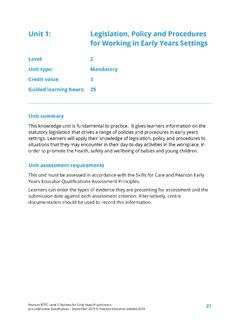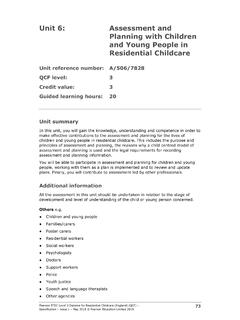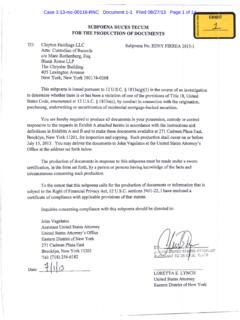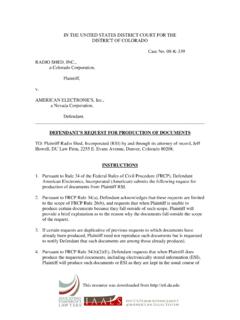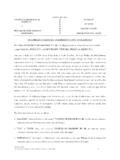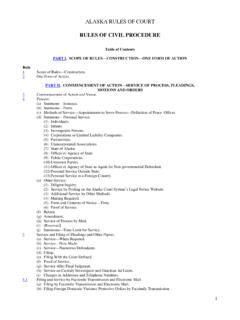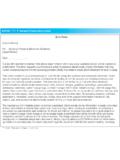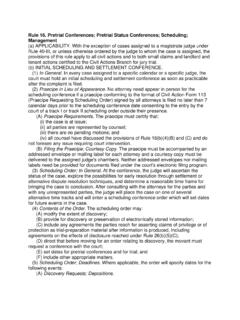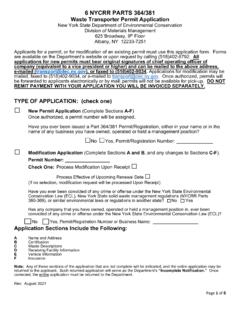Transcription of Unit 4: Principles of Business Document Production and ...
1 Pearson BTEC Level 2 Diploma in Business Administration (QCF) Specification Issue 2 January 2015 Pearson Education Limited 2015 56 Unit 4: Principles of Business Document Production and information Management Unit reference number: T/506/1901 QCF level: 2 Credit value: 3 Guided learning hours: 21 Unit type: Knowledge Unit summary In a Business environment, the Production of documents and the managing of information are crucial skills. Most administrative roles require the job holder to produce documents in a variety of formats, usually using information communication technology to do so. Knowing how to store and distribute documents, and understanding how the management of information contributes to the efficient running of a Business is vital.
2 An important part of these functions is to know the requirements regarding data protection, copyright, intellectual property and the security of data. In this unit you will learn how to prepare different types of Business documents using different types of information communication technology. You will understand the regulatory requirements for producing, storing and distributing documents. You will also learn about the requirements for storing and distributing documents and how information is managed in Business organisations. Pearson BTEC Level 2 Diploma in Business Administration (QCF) Specification Issue 2 January 2015 Pearson Education Limited 2015 57 Learning outcomes and assessment criteria To pass this unit, the learner needs to demonstrate that they can meet all the learning outcomes for the unit.
3 The assessment criteria outline the requirements the learner is expected to meet to achieve the unit. Learning outcomes Assessment criteria 1 Understand how to prepare Business documents Describe different types of Business documents that may be produced and the format to be followed for each Explain the use of different types of information communication technology (ICT) for Document Production Explain the reasons for agreeing the use, content, layout, quality standards and deadlines for Document Production Explain the importance of Document version control and authorisation Explain how the requirements of security, data protection, copyright and intellectual property legislation may affect the Production of Business documents Explain how to check the accuracy of Business documents 2 Understand the distribution of Business documents Explain how the requirements of security, data protection.
4 Copyright and intellectual property legislation may affect the distribution and storage of Business documents Describe different types of distribution channels 3 Understand how information is managed in Business organisations Describe the types of information found in Business organisations Explain the need for safe storage and efficient retrieval of information Describe the features of different types of systems used for storage and retrieval of information Describe the legal requirements for storing Business information Pearson BTEC Level 2 Diploma in Business Administration (QCF) Specification Issue 2 January 2015 Pearson Education Limited 2015 58 Unit amplification This content has been written in an expanded format to facilitate both onscreen testing and portfolio assessment.
5 Learners presenting work for portfolio assessment are not expected to evidence all of the amplification. Learners who are to be assessed by the onscreen test could be tested on any aspect of the amplification. : Describe different types of Business documents that may be produced and the format to be followed for each Business letters: to include formal and informal. Addresses of sender and recipient; date; salutation and complimentary close; paragraphing Reports: title; terms of reference; subheadings; findings; conclusion; recommendations Emails: recipient/s; sender; subject; signature Minutes of meetings: title; date; place; attendees; apologies; matters arising from previous meetings; record of Business ; action points; details of next meeting Lists: alphabetically ordered; numerically ordered Numerical information : tables; graphs; charts Instructions: short phrases; bullets or numbering.
6 Chronological order Newsletters: columns and images Notices and advertisements: no set format or layout : Explain the use of different types of information communication technology (ICT) for Document Production Computer software: word processing software (letters, reports); spreadsheet software (financial records); database software (customer records); customised software (payroll); presentation software (presentations); desktop publishing software (promotional items, newsletters) : Explain the reasons for agreeing the use, content, layout, quality standards and deadlines for Document Production Agreeing the use of content, layout, quality standards and deadlines: Business protocol; follows corporate or house style/identity; professional standards; regulatory requirements; deadlines for completion; confidentiality; ease of use; consistency; meets the needs of user (customer satisfaction).
7 Appropriate for the intended audience Pearson BTEC Level 2 Diploma in Business Administration (QCF) Specification Issue 2 January 2015 Pearson Education Limited 2015 59 : Explain the importance of Document version control and authorisation Document version control: currency of information (ensure up to date version, identify which Document is most up to date, audit trail of changes) Document authorisation: accountability (changes only made by approved personnel, ensuring information is correct, confidentiality) : Explain how the requirements of security, data protection, copyright and intellectual property legislation may affect the Production of Business documents Security: information does not breach security protocols; if security breach Production may need to be minimised or stopped; storing of Business documents may need to be moved Data protection: information is fairly and accurately processed ( information is processed for limited purposes, information is processed in line with an individual's rights, information is stored appropriately); Document may need to be authorised by a manager; produced and communicated on a secure system Copyright: permission to use copyrighted material (copyright licence in place, special copyright conditions); authorisation by manager/other departments may need to be sought Intellectual property: agreements covering ownership of materials.
8 Authorisation by manager/other departments may need to be sought Affect on Production of Business documents: take longer; other people/departments may need to be involved; agreement needed from multiple parties : Explain how to check the accuracy of Business documents How to check accuracy: electronic spelling and grammar checks; proof reading; drafts to originator; figure checking; cross referencing if borrowed material Pearson BTEC Level 2 Diploma in Business Administration (QCF) Specification Issue 2 January 2015 Pearson Education Limited 2015 60 : Explain how the requirements of security, data protection, copyright and intellectual property legislation may affect the distribution and storage of Business documents Security of stored Business documents: physical conditions and locations for paper documents; network or remote archive storage for electronic documents; backup arrangements for electronic documents; archiving policy for identifying stored documents; restricted status Security of distribution: use of secure electronic sites; use of secure systems with public distributors (the Post Office).
9 Use of private couriers Data protection during storage: restricted access; length of time information may be kept for Data protection requirements during distribution: confidential information to authorised recipients only; international restrictions for sending information covered by data protection requirements Copyright requirements during storage: length of time information may be kept for Copyright materials being distributed: copyrighted materials are clearly identified Intellectual property restrictions during storage: length of time information may be kept for Intellectual property being distributed: materials are clearly identified as being the intellectual property of an organisation or individual : Describe different types of distribution channels Electronically: documents sent through email or intranet systems Features: name of recipient and sender is seen; send to multiple recipients; send attachments.
10 Password protect documents that are being sent Paper: documents sent through internal distribution or external distribution Features: convenient; documents for sign off can be sent; no cost for internal distribution Pearson BTEC Level 2 Diploma in Business Administration (QCF) Specification Issue 2 January 2015 Pearson Education Limited 2015 61 : Describe the types of information found in Business organisations Types of information : customer records; financial records; statistical data; policies; procedures; staff records; correspondence; records of service organisations/suppliers : Explain the need for safe storage and efficient retrieval of information Safe storage: confidentiality of information ; regulatory requirements for retaining records Efficient retrieval: time saving; speedy retrieval in emergencies; well organised; archiving : Describe the features of different types of systems used for storage and retrieval of information Storage of physical documentation: o Electronic: remote storage of electronic documents (archive electronic documents on company network, mobile storage for electronic documents) o Paper: remote storage of electronic documents (archive paper documents on-site, archiving paper documents off-site) Retrieval: search procedures (password protection for restricted access; file naming protocols, access keys/cards).


